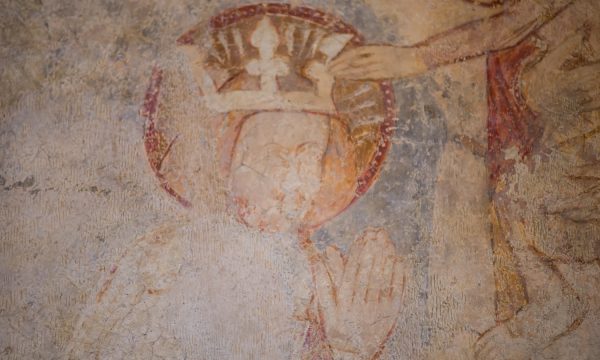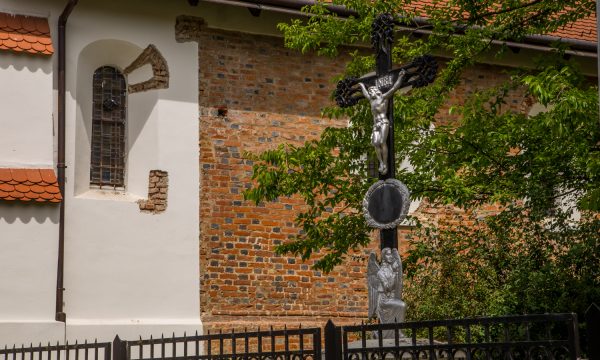Wall painting
The settlement was first mentioned in 1282, as a neighbouring settlement in a deed of donation of a property. In the early centuries of the Middle Ages it was owned by the Baktai family of the Balog-Semjén clan. The settlement and its church did not yet occur in the papal tithe register of 1332–1334. It was assumed that the barrel-vaulted church with a straight closure of the choir, which once had an un-plastered façade, decorated with coloured bricks was built in the 13th century. However, based on recent research it can be mainly dated back to the second half of the 14th century. Its Renaissance western portal preserves the memory of the renovation carried out in 1519.

The settlement already belonged to the Báthori family at the end of the 16th century. At that time, the congregation converted to Protestantism. Klára Károlyi, wife of Gábor Haller bought it back for the Catholics in 1731. At this time, it was significantly restored, extended westward, with its tower built in this same period. There is much information from the first half of the 19th century about the repair works necessary, which were not carried out. In1828 it was mentioned that its medieval buttresses, which were pulled down later, were still standing. A large-scale restoration took place in 1856, when the church received its current form.

Its research as a historic monument started in 1961, when the former plaster layers were removed from its façade, medieval windows were opened at the closure of the choir, and between two openings the mural depicting the Crucifixion was discovered. An extensive research covering all aspects of its restoration was carried out in 2010, as a result of which the restoration of the wall paintings was completed in 2012. Medieval fragments were preserved both in the choir and in the nave. On the vault of its choir there was Christ and the Virgin and Child within a mandorla. A scene from the legend of Saint Elizabeth can be seen in the lower register of its eastern wall. A scene from the legend of Saint Dorothy was painted on the side of the triumphal arch facing the nave, and on the southern wall of the nave we find the story of St. Helena. From the mural fragments, probably the most distinctive one is a mural depicting Saint Ladislaus on the northern wall of the nave. It is not the legend or an independent illustration, but instead it is the holy king kneeling and praying in front of the standing figure of the Virgin holding the Child. Jesus’ right hand is raised in blessing, while he touches St. Ladislaus’ crown with his left hand, as if he were just placing it on his head. On the left side of the painting we can see a standing figure holding a sword in his left hand, and a battle-axe, St. Ladislaus’ main attribute, in his right hand. Similar composition is known only in the Catholic church in Feketeardó (Chornotysiv), in Zakarpattia Oblast, Ukraine. This was also painted on the northern wall of the nave, near the triumphal arch. The only difference is that the Virgin Mary sits on a throne and King Ladislaus is crowned not by Jesus, but by an angel. According to the research, the mural paintings in Baktalórántháza, which are not uniform in style, but were perhaps painted at the same time or successively over a short period of time, can be dated back to the turn of the 14th–15th centuries, but it cannot be ruled out that they were created between 1406–31, during Gergely Baktai’s career, who was perhaps the most prominent member of the family.
Natural Heritage
The oak-hornbeam Baktai Forest is located on the edge of the Middle Nyírség region, west of Baktalórántháza. It is the largest forest in the Nyírség region. The more than 300 ha area of the woods was declared a nature reserve in 1977 in order to preserve this remnant of the woody vegetation that was once characteristic of the region.
The spring plants are probably the most eminent representatives of the forest’s fauna. The large number of crested clarks (Corydalis cava) and fumeworths (Corydalis solida), blossoming even before the first leaves appear on the trees, the bright blue Vinca minor, the early dog-violet (Viola reichenbachiana), and the purple coloured, white flowered bittercress (Cardamine bulbifera) are all defining elements of the area’s plant life. The Centaurea indurata Janka, on the other hand, is a much rarer plant, blossoming at summer’s end.
The decaying stumps of dead trees provide habitats to the various saproxylic life forms (dependent on dead or decaying wood). The larvae of the European rhinoceros beetle (Oryctes nasicornis), the great capricorn beetle (Cerambyx cerdo), and of the stag beetle (Lucanus cervus) all develop inside these decaying trees.
The forest’s avifauna is very diverse as well. Of the songbirds, the Eurasian blue tit (Cyanistes caeruleus), the great tit (Parus major), the Eurasian nuthatch (Sitta europaea), the common blackbird (Turdus merula) and the song trush (Turdus philomelos) can often be heard, but the wood warbler (Phylloscopus sibilatrix) and the collared flycatcher (Ficedula albicollis) may also be observed. The European honey buzzard’s (Pernis apivorus) mating flight can be sighted in May. The birds ‘clap’ their wings above their bodies in order to impress their mates. The name refers to their eating habits, as they feed exclusively on the larvae of wasps and bees.
Of the bats living in the forest, the Barbastelle (Barbastella barbastellus) is a strictly protected species. Preferring a hiding lifestyle, it lives in old, hollow trees. The Bechstein’s bat (Myotis bechsteinii) also dwells in tree holes, but unlike the Barbastelle, it preys on low-flying insects. The Geoffroy’s bat (Myotis emarginatus) visits the area to feed on spiders, flies, and moths too.
The edible dormouse (Glis glis) can be found in the oak-hornbeam forests, on the shrubby, bushy edges of grooves, and even around villages and resorts. It likes fruits and willingly eats the various crops, buds, flowers, or berries it finds.
